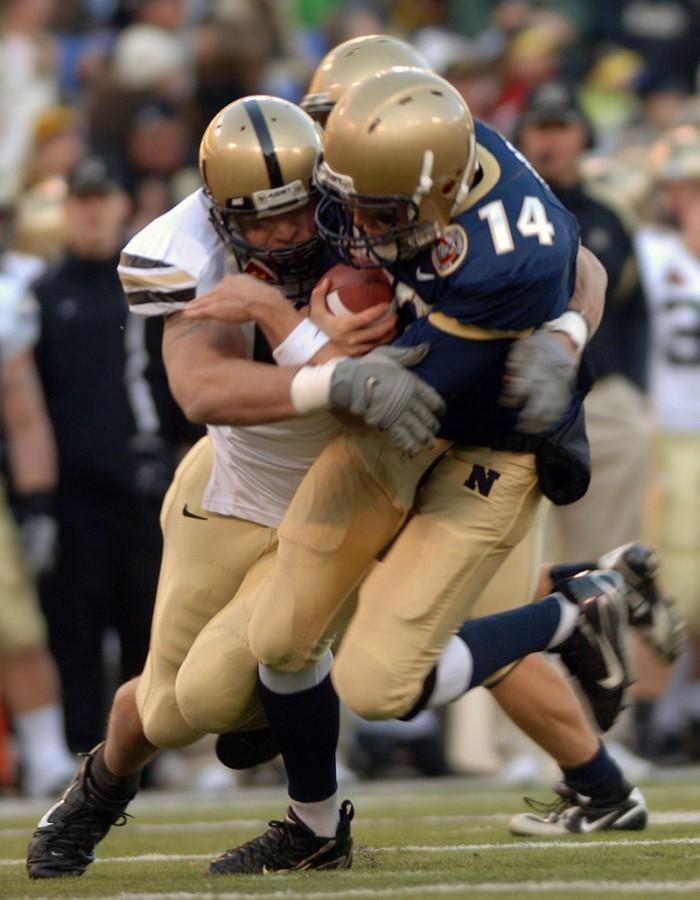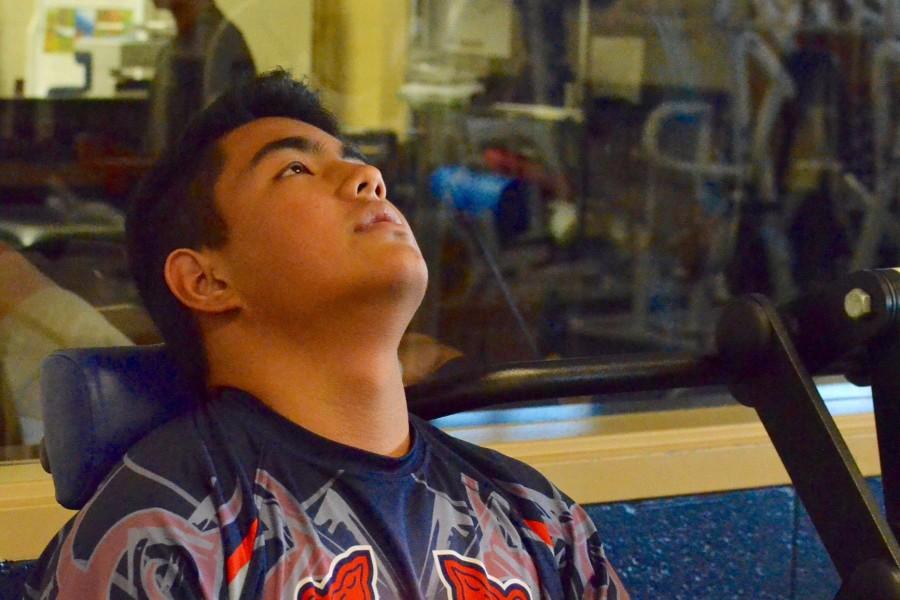Concussions: Silent Killers
December 24, 2015
Photo by U.S. Navy
A football player makes a helmet to helmet tackle during a college football game between Army and Navy at M&T Bank Stadium in Baltimore on Dec. 1, 2007. In 2010, the NFL enforced the helmet to helmet contact rules to preven injuries such as concussion which can result from these kind of hits.
Sports are truly a great experience whether you’re an all star or a first-time participant. They can teach you lessons or help you discover new talents or passions. However, everything comes with a price.
That price could be a concussion. A concussion is a brain injury that results when the brain is jarred in the skull from blunt force. This can be caused by a fall, blow, or injury to the head. The harder the impact, the greater the injury to the brain. Concussions can be fatal in the instance where the brain swells from the impact or blow.
These injuries are not only results from accidents or fights, but from sports as well, whether it be at practice or in a game or match. Some warning signs can include dizziness, problems with balance, sensitivity to light, or even emotional anxiety. Unfortunately, symptoms like these are not always obvious.
Depending on the injury and the person, the symptoms can range from mild to severe. In America, concussions in sports are a growing problem. According the Brain Injury Research Institute, in 2012, there were up to 3.8 million concussions from all activities (not just sports) reported. That is twice the number from 2002.
Statistics show that one in five high school athletes will suffer concussions during their seasons.
The U.S. Centers for Disease Control Heads Up campaign shows that over 90% of concussions will still leave students conscious, therefore making them unaware they even have one. They also found that an estimated 5.3 million Americans live with CDC, which is a disease that comes from a traumatic brain injury.
What makes concussions so dangerous?
Dizziness, sensitivity, mood swings, it’s probably just another headache, right? Wrong! While sports are fun, the same can’t be said about head injuries. They can permanently affect your future and your daily life.
Brain injuries aren’t like broken arms or sprained ankles. They don’t heal within a couple of weeks or months. Nope. You have to live with them for the rest of your life.
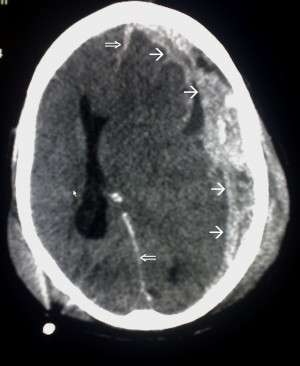
This scan locates the bleeding of brain with the white arrows.
While the dizziness and mood swings can certainly take a toll on someone, there is one factor that is much worse. When the brain swells, it can prove to be fatal. There have been a number of high school athletes who have died as a result of swelling in the brain.
The scenario plays out over and over on football fields across America. It’s game night and running back Joe Football runs for 12 yards, picking up a first down. He passes the first down marker, and “clack!” the middle linebacker cracks him helmet to helmet. The crowd cheers, and the team gets in scoring range and wins the big game. Unfortunately, Joe’s victory is only temporary. His brain swells…and he dies.
According to the Southwest Athletic Trainers Association, “There were 120 sports-related deaths of young athletes in 2008-2009; 50 in 2010; and 40 in 2011.”
Usually people don’t feel the effects right away. In a game, a concussion is not the first thing on an athlete’s mind. They might not report to a trainer to get checked out, and they might return to play because they feel fine at the time, but this is a mistake.
SWATA reports that “50% of “second impact syndrome” incidents – brain injury caused from a premature return to activity after suffering initial injury (concussion) – result in death.” Despite this, SWATA found that “15.8% of football players who sustain a concussion severe enough to cause loss of consciousness return to play the same day.”
Girls are especially at risk. Female soccer players get 40 percent more concussions than males, and female basketball players suffer 240 percent more concussions than males.
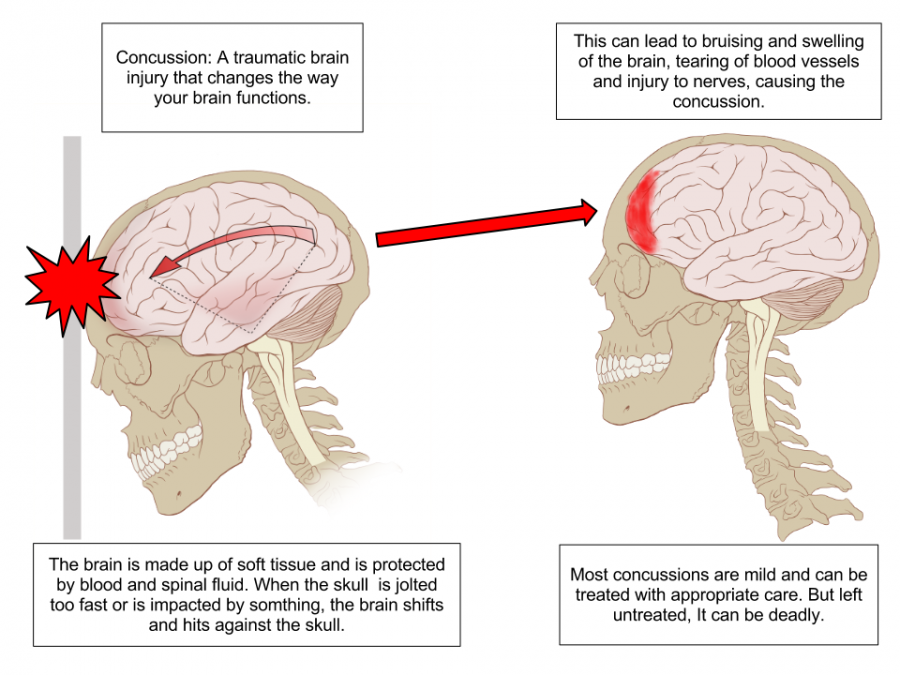
Photo explaining what happens during a concussion.
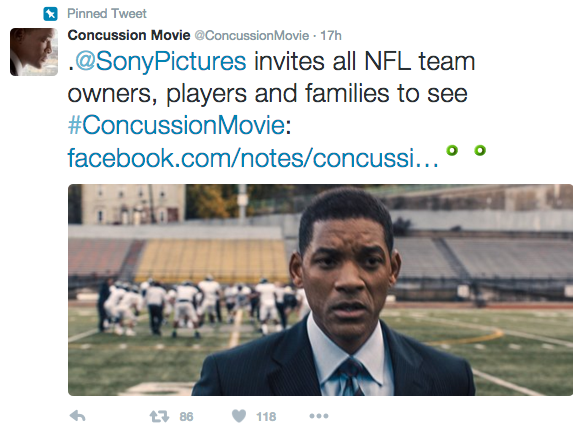
Photo by Screenshot of Concussion Movie promotional tweet
Screenshot of Concussion Movie promotional tweet
Dr. Bennet Omalu
Concussion, a movie about the scientific work of Dr. Bennet Omalu, opens today in movie theaters. You can watch the trailer here, and read on to learn a little about the subject of the film.
Who is Dr. Bennet Omalu? Well, he may be one of the most important people in medical history. Dr. Omalu was the first person to expose his work and findings of chronic traumatic encephalopathy to the public.
Dr. Omalu was born in September 1968 in Nnokwa, Nigeria. At the time he was born, Nigeria was going through a civil war, which caused his family to flee to Enugwu-Ukwu in Southeast Nigeria. Two years later they returned to their original home. His mother was a seamstress and his father was a civil mining engineer.
He discovered CTE in National Football League players in 2002. One of his case studeies was Mike Webster, who played for the Steelers on the offensive line and died unexpectedly.
Before he passed away, he struggled with mental and emotional issues and even attempted suicide. Webster also suffered from drug abuse. With colleagues from the University of Pittsburgh, Dr. Omalu published his research on CTE in 2005 and titled it “Chronic Traumatic Encephalopathy in a National Football League Player.”
That was when he coined the name CTE. In 2006, the Mild Traumatic Brain Injury Committee said his work was “completely wrong” and labeled it as a “failure.”
Later on, Omalu would go on to find the same symptoms in Terry Long, Andre Waters, Justin Strzelczyk and Tom McHale. He showed his findings to Roger Goodell, the NFL’s commissioner, but the work was dismissed. The NFL didn’t recognize the connection with CTE and concussions in the NFL until 2009.
The battle to get recognition from the NFL was a hard-fought one, with Dr. Omalu persevering until he was successful at getting the league to admit the connection between football and CTE. Deadspin.com has an excellent timeline of the significant events that exposed the danger of concussions in the National Football League, leading up to Dr. Omalu’s victory. Click here to read it.
How can you prevent this?
Photo by Kainoa Deguilmo
Jarin Correa does neck-strengthening exercises in the weight room before practice.
To prevent concussions, be sure to use the proper head gear if your sport requires you to do so. If your sport requires a helmet, be sure that it’s comfortable and fits snugly.
Equipment should be well maintained, too. The safer your equipment, the less likely you are to suffer a head injury.
But, you can have the safest equipment in the world, and it won’t mean anything if you don’t use the right form and technique and follow the rules.
For example, it’s important for football players to keep their heads up when they tackle. Being conscious of basics like that and following them can make all the difference.
It’s also important to communicate. If an athletes experience any of the symptoms of concussions, it’s important for them to let a doctor, coach or medical professional know right away.
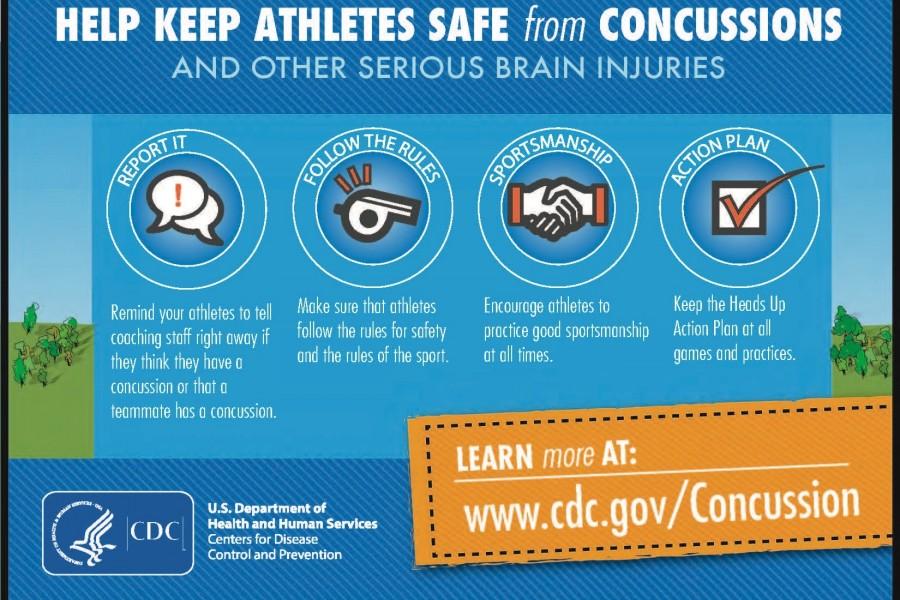
This graphic shows how athletes can minimize their chances of getting a concussion.
Concussion Fast Facts
Here are some quick facts from the Heads Up organization about concussions:
- A concussion is a mild form of traumatic brain injury (TBI) caused by a bump, blow, or jolt to the head. A concussion can also be caused by violent movement or jarring of the head or neck.
- People who suffer from concussions generally recover quickly. However, in some cases, symptoms can last for days or weeks.
- Those who have already had one concussion are more susceptible to another.
- The most common causes of concussions are sports injuries, bicycle accidents, car accidents, and falls.
- For about 9 in 10 people with concussions, symptoms disappear within 7 to 10 days.
- At least 25 percent of concussion sufferers fail to get assessed by medical personnel.
- Most cases of traumatic brain injury are concussions.
- In the U.S., athletes suffer from roughly 300,000 concussions every year.
- Immediate consequences include headache, nausea, vomiting, blurred vision, fatigue, or loss of consciousness.
- Loss of consciousness occurs in less than 10 percent of concussions.
Concussion Q&A: Coach Erin Harkleroad

Coach Erin Harkleroad, an athletic trainer at our school.
Q: What is the importance of students recognizing concussions and reporting them?
A: Well, they can be season-ending for an athlete, or in the worst case, life-ending. If they’re not taken care of, they can lead to serious results.
Q: What can students do to minimize concussions?
A: Students can come to their trainers immediately and report any symptoms they have.
Q: Since working here have concussions been a rising issue, a decreasing issue, or has the rate stayed consistent?
A: Concussions sensitivity has gone way up since the state has become stricter on the regulations. Any head issues or soreness causes athletes to sit out.
Q: Do you see stricter rules as a good thing or bad thing when it comes to concussions and high school athletes?
A: I see it as both. For one, it makes sure students have the help they need in case they actually do have a concussion. But on the other hand, it causes us to pull them out of anything for any sort of head injury, even if it’s not a concussion.
Q: What can students do at practice to work on safety?
A: They can do strength training, especially for their necks. They can also learn form properly. For example, soccer players can practice heading the ball properly, or football players could practice tackling properly.
Amid the Action: Safety is a good thing
Over the years The National Football League has changed. Of course, the have all new players, but it’s the rules that have especially changed.
If you watched a 2015 rival game between the Eagles and Giants versus an 1980’s game between them, you would see very different games. I’m not talking about who would win; I’m talking about the playing. Without a doubt, you would see way more hits in the 1980s game.
Back then, there were no rules about targeting, or hitting a defenseless player, and the hits were often quite vicious. You wouldn’t see Lawrence Taylor getting flagged for body-slamming a quarterback, or Ronnie Lott getting flagged for burying the crown of his helmet into a receiver’s chin.
In today’s games, hits like these still occur, but not nearly as much. In the event that they do, a penalty follows. Old school football had the most brutal hits. Sure, they were exciting, but were they really good?
While people, myself included, can say, “Wow, what happened to head-smashing football?” We have to realize how much of an improvement today’s football is.
Player safety is really important not only for the rest of the athletes’ season, but for the rest of their lives as well. Nobody plays football their whole lives, but the physical effects of playing last well beyond a professional’s career. Former NFL legends suffer from chronic traumatic encephalopathy, or CTE, and its symptoms, like anxiety, depression, and even thoughts of suicide.
In one tragic story, all-star linebacker Junior Seau committed suicide on May 2, 2012. Studies done on his body showed his brain had CTE, which is was first identified by Dr. Bennet Omalu, whose story is being told in the movie Concussion, opening this weekend.
As crazy as it sounds, seeing less big hits wherein a receiver’s head snaps back is a good thing. While wrapping up someone and rolling onto the ground isn’t exactly exciting to watch, it keeps players healthy and able to play throughout the whole game and live full lives after their sports careers are over.
